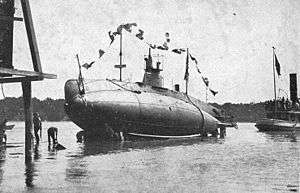USS C-1 (SS-9)
USS C-1 (SS-9) was the lead ship of her class of submarines built for the United States Navy in the first decade of the 20th century.
 USS Octopus (SS-9) | |
| History | |
|---|---|
| Name: | USS Octopus |
| Builder: | Fore River Shipyard, Quincy, Massachusetts |
| Laid down: | 3 August 1905 |
| Launched: | 4 October 1906 |
| Commissioned: | 30 June 1908 |
| Decommissioned: | 4 August 1919 |
| Renamed: | C-1, 17 November 1911 |
| Fate: | Sold for scrap, 13 April 1920 |
| General characteristics | |
| Class and type: | C-class submarine |
| Displacement: |
|
| Length: | 105 ft 4 in (32.11 m) |
| Beam: | 13 ft 11 in (4.24 m) |
| Draft: | 10 ft 11 in (3.33 m) |
| Installed power: |
|
| Propulsion: |
|
| Speed: |
|
| Range: |
|
| Test depth: | 200 feet (61.0 m) |
| Complement: | 15 officers and enlisted |
| Armament: | 2 × 18 inch (450 mm) bow torpedo tubes (4 torpedoes) |
Description
The C-class submarines were enlarged versions of the preceding B class, the first American submarines with two propeller shafts. They had a length of 105 feet 3 inches (32.1 m) overall, a beam of 13 feet 10 inches (4.2 m) and a mean draft of 10 feet 10 inches (3.3 m). They displaced 240 long tons (240 t) on the surface and 273 long tons (277 t) submerged. The C-class boats had a crew of 1 officer and 14 enlisted men. They had a diving depth of 200 feet (61.0 m).[1]
For surface running, they were powered by two 240-brake-horsepower (179 kW) Craig gasoline engines, each driving one propeller shaft. When submerged each propeller was driven by a 115-horsepower (86 kW) electric motor. They could reach 11 knots (20 km/h; 13 mph) on the surface and 9 knots (17 km/h; 10 mph) underwater. On the surface, the boats had a range of 776 nautical miles (1,437 km; 893 mi) at 8.13 knots (15.06 km/h; 9.36 mph) and 24 nmi (44 km; 28 mi) at 8 knots (15 km/h; 9.2 mph) submerged.[1]
The boats were armed with two 18 inch (450 mm) torpedo tubes in the bow. They carried two reloads, for a total of four torpedoes.[2]
Construction and career
C-1 was laid down by Fore River Shipbuilding Company in Quincy, Massachusetts, under a subcontract from Electric Boat Company, as Octopus. Octopus was launched on 4 October 1906 sponsored by Miss F. Webster, and commissioned on 30 June 1908, Lieutenant C. E. Courtney in command. She was renamed C-1 on 17 November 1911. Assigned to Submarine Flotilla 2 (SubFlot 2), Octopus operated out of Newport, Rhode Island and New York City until 9 October 1908. Tests and experiments, of both submarine design and the tactical use of her type, continued from Norfolk, Virginia and Newport until she was placed in reserve at Charleston, South Carolina on 14 February 1910. Recommissioned on 15 April, the submarine conducted experiments and served as training vessel at Newport until 10 May 1913. C-1 was reassigned to Submarine Group 1, Torpedo Flotilla, Atlantic Fleet, and from 29 May-7 December operated out of Guantánamo Bay, Cuba. She served in Panamanian waters in training, and later, on patrol during World War I until 4 August 1919, when she was decommissioned at Coco Solo in the Panama Canal Zone. Here, she was sold on 13 April 1920.
In Literature
A fictional submarine named USS Octopus appears in Edward L. Beach's 1955 novel Run Silent, Run Deep.
Notes
- Friedman, p. 306
- Gardiner & Gray, p. 127
References
- Friedman, Norman (1995). U.S. Submarines Through 1945: An Illustrated Design History. Annapolis, Maryland: Naval Institute Press. ISBN 1-55750-263-3.
- Gardiner, Robert & Gray, Randal, eds. (1985). Conway's All the World's Fighting Ships: 1906–1921. Annapolis, Maryland: Naval Institute Press. ISBN 0-85177-245-5.
- This article incorporates text from the public domain Dictionary of American Naval Fighting Ships. The entries can be found here and here.
External links
- Photo gallery of USS Octopus at NavSource Naval History